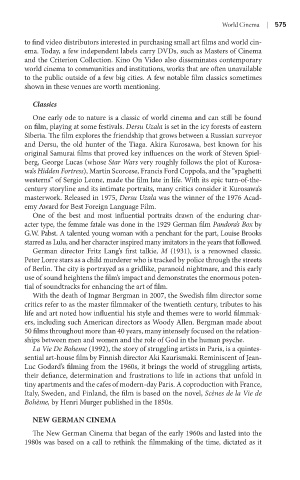Page 596 - Battleground The Media Volume 1 and 2
P. 596
World C nema |
to find video distributors interested in purchasing small art films and world cin-
ema. Today, a few independent labels carry DVDs, such as Masters of Cinema
and the Criterion Collection. Kino On Video also disseminates contemporary
world cinema to communities and institutions, works that are often unavailable
to the public outside of a few big cities. A few notable film classics sometimes
shown in these venues are worth mentioning.
Classics
One early ode to nature is a classic of world cinema and can still be found
on film, playing at some festivals. Dersu Uzala is set in the icy forests of eastern
Siberia. The film explores the friendship that grows between a Russian surveyor
and Dersu, the old hunter of the Tiaga. Akira Kurosawa, best known for his
original Samurai films that proved key influences on the work of Steven Spiel-
berg, George Lucas (whose Star Wars very roughly follows the plot of Kurosa-
wa’s Hidden Fortress), Martin Scorcese, Francis Ford Coppola, and the “spaghetti
westerns” of Sergio Leone, made the film late in life. With its epic turn-of-the-
century storyline and its intimate portraits, many critics consider it Kurosawa’s
masterwork. Released in 1975, Dersu Uzala was the winner of the 1976 Acad-
emy Award for Best Foreign Language Film.
One of the best and most influential portraits drawn of the enduring char-
acter type, the femme fatale was done in the 1929 German film Pandora’s Box by
G.W. Pabst. A talented young woman with a penchant for the part, Louise Brooks
starred as Lulu, and her character inspired many imitators in the years that followed.
German director Fritz Lang’s first talkie, M (1931), is a renowned classic.
Peter Lorre stars as a child murderer who is tracked by police through the streets
of Berlin. The city is portrayed as a gridlike, paranoid nightmare, and this early
use of sound heightens the film’s impact and demonstrates the enormous poten-
tial of soundtracks for enhancing the art of film.
With the death of Ingmar Bergman in 2007, the Swedish film director some
critics refer to as the master filmmaker of the twentieth century, tributes to his
life and art noted how influential his style and themes were to world filmmak-
ers, including such American directors as Woody Allen. Bergman made about
50 films throughout more than 40 years, many intensely focused on the relation-
ships between men and women and the role of God in the human psyche.
La Vie De Boheme (1992), the story of struggling artists in Paris, is a quintes-
sential art-house film by Finnish director Aki Kaurismaki. Reminiscent of Jean-
Luc Godard’s filming from the 1960s, it brings the world of struggling artists,
their defiance, determination and frustrations to life in actions that unfold in
tiny apartments and the cafes of modern-day Paris. A coproduction with France,
Italy, Sweden, and Finland, the film is based on the novel, Scènes de la Vie de
Bohème, by Henri Murger published in the 1850s.
nEw gErman CinEma
The New German Cinema that began of the early 1960s and lasted into the
1980s was based on a call to rethink the filmmaking of the time, dictated as it

